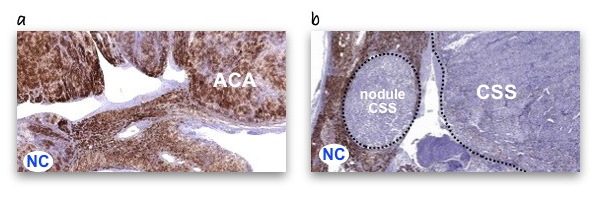Adrenocortical carcinoma (ACC) is a rare and aggressive tumor with poor prognosis and very limited therapeutic options. The complexity and heterogeneity of the molecular alterations identified in ACC are involved in resistance to conventional chemotherapy as well as to targeted therapies. Over the last decade, microRNAs have emerged as very powerful biomarkers in oncology. MicroRNAs are small non-coding RNAs that repress gene expression at the post-transcriptional level by inducing target mRNA degradation or inhibition of translation. Due to their ability to modulate the expression of several genes at once, microRNAs are promising therapeutic targets for cancer. In contrast to significant advances made for common cancers, the role of microRNAs (miRs) in the pathogenesis of ACC is largely unknown
[1]. Researchers from our laboratory have previously identified tumor and serum microRNAs signatures which were predictive of recurrence risk for ACC patients
[2]. Notably, they found that tumor overexpression of both miR-483-5p and miR-139-5p microRNAs allows to discriminate between aggressive ACC (recurrent and/or metastatic) and indolent ACC.
A recent study by the team aimed to identify the target genes of these two microRNAs in order to define their role in the physiopathology of ACC. The researchers used an original approach based on bioinformatic analyzes combining expression profiles of mRNAs and microRNAs, with microRNA target gene prediction softwares. They were able to identify two members of the
N-myc Downstream Regulated Genes family,
NDRG2 and
NDRG4, as target genes for miR-483-5p and miR-139-5p respectively
[3]. The function of these 2 genes in adrenal cortex carcinogenesis is currently unknown.
NDRG2 has been described in other cancers as a repressor of several oncogenic cell signaling pathways while the mechanism of action of
NDRG4 remains to be elucidated.
The researchers showed that the overexpression of miR-483-5p and miR-139-5p correlates with a loss of expression of both genes in
two independent cohorts* of patients with ACC. These results were confirmed by immunohistochemistry on a third cohort of patients from Grenoble University Hospital (
Figure 1).

Figure 1 a) Detection of the NDRG4 protein using specific antibodies (brown staining) in adrenocortical adenoma (benign tumor or ACA). b) Absence of the NDRG4 protein, therefore of staining, in the case of an aggressive ACC.
NC: Normal adrenal cortex.
The expression levels of NDRG4 or of its regulatory miR, miR-139-5p, allows to distinguish aggressive ACC from indolent ACC and are both striking prognostic factors (
Figure 2).
Inhibition of miR-483-5p or miR-139-5p or re-expression of their target genes
NDRG2 and
NDRG4 in two human ACC cell lines hinders their invasiveness and decreases the expression of markers involved in the epithelial-mesenchymal transition, a key process in metastatic spread.
This study shows for the first time that miR-483-5p and miR-139-5p together with their target genes
NDRG2 and
NDRG4 are involved in the aggressive phenotype of adrenocortical carcinoma, and should contribute to the development of new diagnostic / prognostic and therapeutic approaches for this cancer.
* The
two independent cohorts of 64 ACC come from the national COMETE network's tumor biobank (Reference center for rare adrenal diseases, Hôpital Cochin, Paris).